27.06.2005
S.Ivanov. The supertournament in Sofia: no compromise and struggle evasion!
The first experiment with the rule that forbids chessplayers to agree to a draw by mutual consent is completed. Let us try to examine its results and to find an answer to a question: what threats does such an innovation bring to players, amateurs and chess itself.
I remind you that the chief organizer of the tournament in Sofia Silvio Danailov set the following conditions for the participants: chessplayers had no right to negotiate with each other during the game, and only an arbiter could declare a draw in 3 possible cases:
1) threefold repetition
2) perpetual check
3) theoretically drawn position (grandmaster Zurab Azmaiparashvili stood as an arbiter's assistant)
By the way, if I'm not wrong, it was Mark Dvoretsky who firstly proposed such a drastic mean against short and prearranged draws in his interview that was published on our site. Therefore, we can feel that we took part in great revolutionary events.
First impressions are the following: this experiment was successful, and it should be spread over the other chess competitions. All the observers mention increased tension of a struggle and greater number of hard-edged, tense and fighting encounters. However, the percentage of decisive games did not grow: 12 encounters out of 30 played in Sofia ended in a victory of one of the parties (White had an advantage: +9-3=18), though it is well-known that there are different kinds of draws! One thing is to "paddle" 20 moves and more, then to go aside, and if the opponent turns out to be well-armed, ask for an agreement straight away. It is quite another matter, when the participants must play on! There will be no possibility to take a rest at the right moment, one must go all out, and no references to tiredness, poor preparation, headache and so on will be accepted. Recently we have deepened too much in science, computer training etc, but let us remember that chess is firstly a struggle between two personalities and after all a sport. Anyway, everything is decided directly at the board, and the winner is more determined, more inventive and tougher at some instant.
Vishy Anand expressed himself very precisely on this subject. When he was asked: "Why there are so many short draws in the supertournaments?", the burden of what he said was the following: "for the fear of losing!" It is natural for a human to try subconsciously minimizing the risk of a defeat, and when a position that is hard to calculate emerges on the board, many players rely on a possibility of agreement like on a saving straw. If there is no such opportunity at all, it is even easier to play: there are no outside thoughts and doubts, and you can entirely concentrate on calculating variations and evaluating positions.
Thus, the first conclusion on the results in Sofia should refer to the players themselves: now they will not have an opportunity to stop the game in an unclear position, they must play till the end, and this condition considerably increases the requirements to the level of concentration, endurance and physical form. It is noteworthy that after the first half Kramnik and Adams were leading and Topalov was at the last place, however, in the end Topalov confidently climbed to the first line of the table, while Kramnik and Adams (also very confidently) shared the last place. This situation is very easy to explain: Topalov has an excellent physical form (I remind you that in Linares he also managed to catch up with Kasparov in a final round), while Kramnik has been complaining for several months that he cannot recuperate and come to his senses after the match with Leko. Therefore, blunders and errors that are hard to explain pursued Vladimir during the second part of the tournament – the tiredness due to the necessity of fighting till the end in every game was multiplied by the lack of proper concentration. In my opinion, it is impossible to explain the blunder of Kramnik in the game against Topalov (34.¤с1??) by other reasons.
Now let us consider the quality of the games played, or, more precisely, the quality and the manner of struggle on board. The average length of games at the tournament in Sofia was 48 moves – it is obviously longer than in most other supertournaments. There were almost no cases of struggle evasion, only several times the opponents repeated the moves in unclear positions (Topalov – Adams and Anand – Ponomariov in the 1st round). Several times games ended with a perpetual check, and in some encounters a draw was registered in absolutely equal positions (nothing is said about any resort to grandmaster Azmaiparashvili). Generally, the games lasted literally till bare kings (by the way, three of Anand's games came to such an end – against Polgar and Adams in the 1st half and against Ponomariov in the 2nd half). It is funny that the shortest encounter (20 moves) turned out to be ... a decisive one (Anand defeated Kramnik as White)!
Only one conclusion suggests itself after all mentioned above: a true chess supporter only benefits from the "antidraw" innovation. You can agree that it is much more interesting and fascinating to observe a chess encounter (even if it ends in a draw), if it is full of struggle, unexpected maneuvers, blows and counterblows, study-like ideas in the endgame, in general – everything that makes chess attractive. The sponsors will surely pay up for such games and such tournaments, while 15-20-move games, when a step aside the theory leads to an agreement, will not be supported. In heated discussions about the future of chess and the means of call investments in chess that are constantly carried out recently, the tournament in Sofia is a serious argument. It has already agreed that one has to create a "product that would be demanded at the market" to find money for chess. The last supertournament gave a simple answer to this question – you just have to play like in Sofia, and you will have the product and money in chess!
Let us try to model this situation: how the necessity to fight till the end will influence the game itself, will any changes in the theory of opening, middlegame and endgame happen? I think, this should lead to the fact that in the opening players will aim at going away from the "official" theory as soon as possible, they will carry out more experiments, try their own variations that were unknown before. Among the chess elite, only Morozevich plays in such a style, but later on the others will perhaps come to it as well. Chess will be "fresher", it will receive new impulses for development; besides, some ideas of the "Fischer chess" will be particularly realized.
It is hard to say something definite about the middlegame play. Global changes can hardly happen, but this rule will surely affect the evaluation of a variety of endgame positions. And it is not improbable that it will lead to their revaluation. There are quite a few endings that regarded to be drawn (e.g.: rook ending 4 vs 3, rook and bishop vs. rook, queen with edge pawn vs. queen). This conclusion is made mainly on the basis of research and textbook examples, however, when these endings rarely occur in practice, the weaker side by no means always achieves a desired drawn result. It frequently happens that a chessplayer is not happy to come to a rook ending 4 vs. 3 that emerges from a position with an advantage, because this ending is considered to be impossible to win. And he agrees to a draw or chooses another line. In case when this agreement to a draw becomes difficult, players will have to play such endings more often, search for winning means (and surely they will find them!), and thus they will develop the endgame theory. I am sure that many wonderful discoveries that recast the experience of previous generations are waiting for us. We have already witnessed such examples in Sofia.
In brief, these are preliminary results of the first "antidraw" experiment in the modern history of chess and analysis of its possible consequences. Now let us examine some of the most prominent and typical examples of the participants' competitive achievements. The course of this competition was covered on our website, on the site www.chesspro.ru you can find detailed annotations of grandmaster Sergei Shipov to all the games (but only in Russian).
The winner of the tournament Veselin Topalov played some outstanding games: two encounters with Anand, and games with Adams and Polgar in the second half. However, I think that the next brilliant masterpiece characterizes his performance in the best way.
Topalov – Ponomariov (9th round) E15
1.d4 ¤f6 2.c4 e6 3.¤f3 b6 4.g3 Ґa6 5.b3 Ґb4+ 6.Ґd2 Ґe7 7.¤c3 0–0. Perhaps after this encounter one will say that 7...c6 is more precise, e.g.: 8.e4 d5 9.e5 ¤e4 10.Ґd3 ¤xc3 11.Ґxc3 0–0 12.0–0 c5 13.dxc5 bxc5 14.cxd5 exd5 15.Ґxa6 ¤xa6 16.Јd3 ¤b8 17.¦ad1 d4 18.Јe4 ¤d7 with rather equal game (Ionov - Jakovenko, St.Petersburg 2005).
8.¦c1!? A sly move. The main continuation is 8.e4 d5 9.cxd5 Ґxf1 10.ўxf1 exd5 11.e5 ¤e4 and so on.
8...c6 9.e4 d5
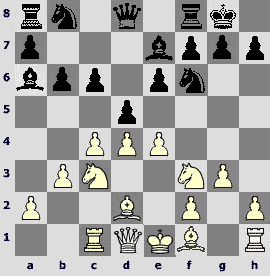
10.e5! It is strange that such a drastic and natural continuation turns out to be a novelty. Earlier Topalov used 10.Ґd3 dxe4 11.¤xe4 ¤bd7 12.¤xf6+ ¤xf6 13.Ґc3 c5 14.dxc5 Ґxc5 15.Јe2 Ґb7 16.0–0 h6 17.b4 Ґe7 18.¦fd1 Јc7 19.Ґxf6 Ґxf6 20.Ґe4 Ґxe4 21.Јxe4 a5, and Black has no a shadow of complications (Topalov – Gelfand, Monaco 2004).
10...¤e4 11.Ґd3 ¤xc3. 11...¤xd2 12.Јxd2 ¤d7 13.0–0 f6 looks safer – the chances of both sides are equal.
12.¦xc3. An important nuance: according to the game Ionov – Jakovenko White can capture with a rook.
12...c5 13.dxc5 bxc5?! This self-suggesting move seems to be a serious inaccuracy. He should continue by 13...d4! 14.¦c1 Ґb7, somewhat disturbing the coordination of white pieces with a temporary pawn sacrifice. It seems that there is nothing better for White than 15.0–0 (doubtful is 15.cxb6 Јxb6 16.0–0? Јc6 17.ўg2 f6! 18.¦e1 fxe5 19.Ґe4 Јxe4°) 15...bxc5 16.Јe2 ¤d7, whereupon the position becomes rather equal.
14.h4!
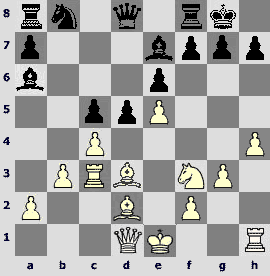
With a dangerous threat on Ґh7, ¤g5 and a mating attack. The rook turns out to be well-placed on h1.
14...h6. Now 14...d4? is losing: 15.Ґxh7+! ўh8 (15...ўxh7 16.¤g5+ ўg8 17.Јh5 Ґxg5 18.hxg5 f5 19.g6, and White mates) 16.¦c1 g6 17.h5 ўxh7 18.hxg6+ ўg8 19.¤xd4! with decisive threats. Maybe Black could play 14...Јc7 aiming at the e5-pawn (with check), and a combination with the sacrifice on h7 does not work. In reply to this 15.ўf1! is very strong (15.Ґf4 Јa5 is not successful), resuming the threat of capturing on h7. To all appearances Black cannot avoid the move h7-h6.
15.Ґb1. White fails to sacrifice a light-squared bishop – it will be useful to create a battery. However, his hour still will strike!
15...f5? This is already an irreparable mistake. Bad is also 15...d4 16.Јc2 g6 17.¦d3 h5 in view of 18.g4! hxg4 19.h5!, e.g.: 19...gxf3 20.¦xf3 Јc7 21.hxg6 Јxe5+ 22.Јe4 ¤c6 23.g7!ќ (indicated by S. Shipov).
The only defense consisted in the move 15...¤d7, so Black could parry 16.Јc2 by means of 16...f5 17.ef6 ¤f6 18.Ґh6 ¤e4! with an unclear play. However, White can play subtler: 16.Ґxh6!? Now bad is 16...gxh6? 17.Јc2 f5 18.exf6 ¦xf6 (18...¤xf6 19.Јg6+ ўh8 20.¤g5ќ) 19.Јh7+ ўf8 20.¤g5! with a quick mate. Only 16...f5! remains, e.g.: 17.Ґf4 dxc4 18.bxc4 (18.¤g5 Јa5) 18...Јa5. Black defended against a direct mating attack, and can recon on a counterplay that compensates for his pawn deficit.
16.exf6 Ґxf6 17.Јc2 d4. Bad is 17...Ґxc3 18.Ґxc3 d4 19.Јh7+ ўf7 20.Јg6+ ўe7 (20...ўg8 21.¤e5) 21.¤xd4! cxd4 22.Јxg7+ ўd6 23.Ґb4+ ўc6 24.Ґe4+ ўb6 25.Јe5ќ.
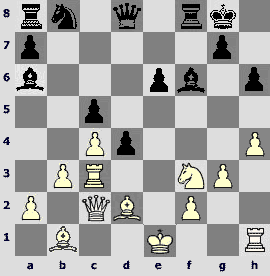
Now we see a deep and accurately calculated combination.
18.¤g5! hxg5 19.hxg5 dxc3 20.Ґf4. An alternative is 20.¦h8+ ўf7 21.Јg6+ ўe7 22.gxf6+ gxf6 23.¦h7+ ўd6 24.Ґf4+ e5 25.Ґxe5+!ќ.
20...ўf7. The king tries to decamp. In case of 20...Ґd4 decisive would be 21.Јg6! with a threat on ¦h8.
21.Јg6+ ўe7 22.gxf6+ ¦xf6 23.Јxg7+ ¦f7 24.Ґg5+ ўd6 25.Јxf7 Јxg5 26.¦h7!
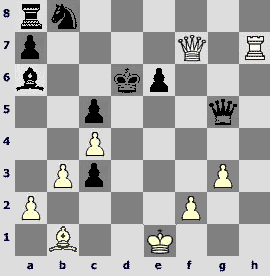
It is a final touch! The black king cannot get out of the mating net without serious losses.
26...Јe5+. After 26...Јd8 27.Јf4+ ўc6 28.Ґe4+ ўb6 29.Ґxa8 c2 30.Јd2 White has a decisive material advantage.
27.ўf1 ўc6 28.Јe8+ ўb6 29.Јd8+ ўc6 30.Ґe4+! And the bishop delivers a decisive blow! In view of an inevitable mate Ponomariov resigned.1–0
In a certain sense this outstanding crushing defeat turned out to be a revenge of Topalov for the same action that Ponomariov committed with him in the 1st half.
Ponomariov – Topalov (5th round)
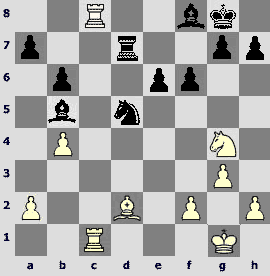
It seems that Black has quite good prospect: he has 2 bishops, strong knight on d5, it remains only to play ўf7. However, as everybody knows, in chess players move in turns!
24.¤h6+! This sacrifice is purely intuitive. White has no direct win, but the opponent is bound hand and foot, and his serious material advantage does not tell.
24...gxh6 25.Ґxh6 ¦f7. Unsuccessful is also 25...¦g7 26.¦a8 ўf7 27.¦xa7+ Ґe7 28.Ґxg7 ўxg7 29.a4 – the passed a-pawn should decide the issue of the fight.
26.¦d8 ¤e7 27.¦c7 ¤g6 28.¦cc8. Tightly chaining black pieces to a defense of the f8-bishop, White threatens with h2-h4-h5, winning.
28...e5 29.f4. After 29.h4 Black holds by means of 29...Ґe2 30.ўg2 e4. And in case of 29.f3 Ґd7 30.¦b8 saving is 30...Ґh3! that blocks the movements of the h-pawn.
29...Ґd7 30.¦a8 Ґh3 31.ўf2
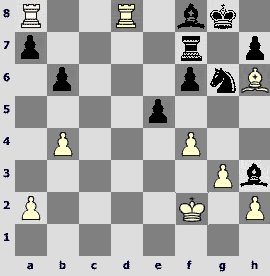
Provided a full of pieces board Black has a real Zugzwang! Light-squared bishop has to watch over the h-pawn, the other pieces by definition do not move. It remains only to move the pawns.
31...b5. Or 31...e4 32.a4! f5 33.a5 bxa5 34.bxa5 Ґg4 35.a6 Ґh3 36.ўe3 Ґg4 (36...Ґf1 37.h4) 37.¦db8 Ґh3 38.¦b7, the fight finishes with the loss of a7-pawn (indicated by Shipov).
32.¦db8 exf4 33.gxf4 Ґd7 34.h4! Black already has no defense.
34...Ґc6 35.h5 Ґxa8 36.hxg6 hxg6 37.¦xa8 f5 38.ўg3
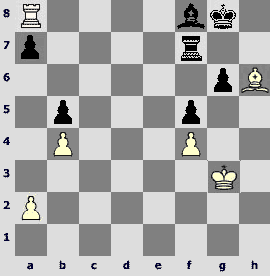
The plan of White is very easy – to move the king on g5 and to exchange on f8 passing to the pawns endgame. Black is not able to prevent from it.
38...a6 39.ўh4 ¦g7 40.ўg5 1–0
As regards the opening preferences, the Petroff has returned to the charts, just like in some of previous supertournaments. This opening occurred in 8 games, however, its reputation of being "fireproof" was slightly staggered: White won 3 times having 1 defeat and 4 draws. What is noteworthy that the apologists of this opening themselves received all the "breaches": Kramnik and Adams (Adams lost to Anand as White, though defeated Kramnik also as White). The defeats of Vladimir Kramnik in the Petroff deserve special attention.
Adams – Kramnik (3rd round) C42
1.e4 e5 2.¤f3 ¤f6 3.¤xe5 d6 4.¤f3 ¤xe4 5.d4 d5 6.Ґd3 ¤c6 7.0–0 Ґe7 8.c4 ¤b4 9.Ґe2 0–0 10.¤c3 Ґf5 11.a3 ¤xc3 12.bxc3 ¤c6 13.¦e1 ¦e8 14.cxd5 Јxd5 15.Ґf4 ¦ac8
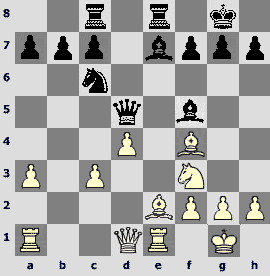
It is a tabia of the Petroff during some recent years. White tasted a great majority of continuations in this position; therefore it is even more noteworthy that two valuable novelties were shown at the tournament in Sofia.
16.Ґg3!? This continuation is quite logical – White drives away the bishop from the loose location, which could tell in a variation like 16.c4 Јe4 17.Ґe3 Јc2!, and Black easily solves the opening problems: 18.d5 ¤a5 19.¤d4 Јxd1 20.¦exd1 Ґd7 21.Ґd2 Ґf6 22.Ґxa5 Ґxd4 23.¦xd4 ¦xe2 Ѕ–ЅLeko – Kramnik, Brissago 2004. In the encounter Polgar – Kramnik of the 9th round White preferred to play 16.Ґd3, and it was already Kramnik, who used a bright novelty: 16...b5!? (earlier one tried 16...Јd7 17.¦b1 Ґxd3 18.Јxd3 b6 19.d5 Ґf6 20.c4 h6 21.h3 ¤e7 22.¤e5 Ґxe5 23.¦xe5 ¤g6 24.¦xe8+ ¦xe8 25.Ґg3, and Black still has certain problems, Anand –Shirov, Monte Carlo 2005) 17.Јb1 Ґxd3 18.Јxd3 a6 19.a4 b4 20.¦ac1 Ґf6 21.¦xe8+ ¦xe8 22.cxb4 ¤xb4 23.Јc3 ¤a2 24.¦e1 ¦xe1+ 25.Јxe1 h6 26.Ґxc7 Ґxd4 with an absolute equality.
There were other examples: 16.h3 h6 17.¤d2 Јd7 18.¤c4 Ґd6 19.Јd2 Ґxf4 20.Јxf4 ¦e4 21.Јg3 ¦ce8 22.¤e3ІKasparov – Motylev, Moscow 2004. A short draw was fixed in an earlier encounter of these opponents: 16.¤d2 ¤a5 17.Ґf3 Јd7 18.¤f1 Ґd6 19.¦xe8+ ¦xe8 20.Ґxd6 cxd6 21.¤e3 Ґe4 22.h3 Ѕ–ЅAdams – Kramnik, Wijk aan Zee 2005.
However, now Adams seems to be in a fighting mood.
16...Ґf6. The standard answer is that Black prevents a central pair of white pawns from moving in the centre. An exchange of dark-squared bishops looks quite good: 16...Ґd6 17.¤d2 Ґxg3 18.hxg3 ¤a5! (planning c7-c5) 19.Јa4 Ґd7 20.Јc2 b6 21.Ґd3 h6 22.Ґh7+ ўf8 23.Ґe4 Јd6 24.¤f3 Ґe6=. Black has entirely equalized the game (Adams – Anand, 9th round).
17.¤d2 Јa5 18.Јc1
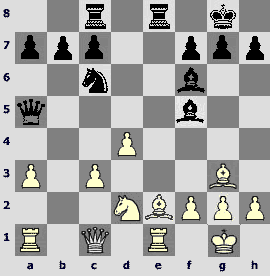
And here an unexpected thing happened...
18...Ґxd4?! It is bold, drastic, but ... absolutely in style of Kramnik. And frankly, this position does not look calling for so thoroughgoing measures as a piece sacrifice for 2 pawns. A quiet 18...Ґg5 would preserve quiet an acceptable play for Black.
19.cxd4 ¤xd4 20.Ґc4! Obviously weaker is a passive 20.Ґf1 ¦xe1 21.Јxe1 ¤c2 22.Јd1 ¤xa1 23.¤c4 Јc5 24.Јxa1 Ґe6 with quite good counterplay of Black.
20...¤c2. After the game Kramnik said that he had counted a quite long variation – 20...¦xe1+ 21.Јxe1 ¤c2 22.Јe7! ¤xa1 (22...Јxd2 23.Јxf7+ ўh8 24.Јxf5ќ) 23.Ґxf7+ ўh8 24.Ґe5! Јxd2 25.Ґxg7+ ўxg7 26.Ґe8+ ўh6 27.Јf8+ ўg5 28.f4+! ўxf4 (28...Јxf4 29.Јe7+ ўg4 30.h3+ ўg3 31.Јe1+ќ; 28...ўg4 29.Ґh5+! ўxh5 30.Јxf5+ ўh6 31.Јg5#) 29.Јh6+ ўe5 30.Јxd2 ¦xe8 31.Јe2+ Ґe4, and having achieved this position, he missed the move 32.Јh5+ that was winning a rook. We should admit that all moves of White are perhaps the only possible ones and finding them at the board was a push-over for Adams.
21.¦xe8+! Once again it is the most precise move. In case of 21.¦d1 ¤xa1 22.Јxa1 b5 23.Ґf1 c5 black passers would become very dangerous.
21...¦xe8 22.¦b1 ¦e1+. Black has to remove the queen, after 22...Јxa3 23.Јxa3 ¤xa3 24.¦a1 ¤xc4 25.¤xc4 White wins one of the pawns and preserves great chances for a victory.
23.Јxe1 ¤xe1 24.¦xe1 ўf8 25.¤f3 f6. Provided 25...Јxa3 26.Ґxc7 Јc5 27.Ґf4! Black cannot capture the c4-bishop in view of Ґd6 and ¦e8#.
26.¦d1 Јc5 27.Ґf1
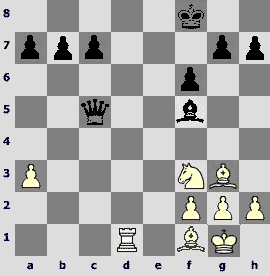
Thus the position became clear. Although there is a formal material equality on the board, an obvious advantage is on the side of White. It is hard for Black to promote his passed pawns, at the same time coordinated white pieces easily launch an attack on the black king. Moreover, Kramnik got into Zeitnot, and the position turned out to be hopeless even though he had managed to get to the time control. Moral of the whole history says that it is better not to give pieces in the opening when it is no particular need. (1–0)
Anand – Kramnik (7th round) C42
1.e4 e5 2.¤f3 ¤f6 3.¤xe5 d6 4.¤f3 ¤xe4 5.d4 d5 6.Ґd3 ¤c6 7.0–0 Ґe7 8.c4 ¤b4 9.Ґe2 0–0 10.¤c3 Ґf5 11.a3 ¤xc3 12.bxc3 ¤c6 13.¦e1 ¦e8 14.cxd5 Јxd5 15.Ґf4 ¦ac8. For the time being there are no changes.
16.Јc1!? It is another novelty, but the idea remains the same – to defend the dark-squared bishop.
16...¤a5. We can consider both 16...Ґf6 and 16...Ґd6 as other alternatives.
17.c4
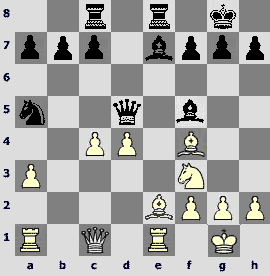
Who could imagine at the moment that there were only 3 moves till the end of the game!
17...Јe4?? Hoping to make an exchange of queens on the c2-square that is already known from the encounter with Leko, Kramnik falls into a prepared trap. Surely, he should have retreated –17...Јd8, and after an exemplary 18.Јc3 c5 19.d5 Ґf6 20.Ґe5 Ґxe5 21.¤xe5 Јf6 22.f4 b6 the chances of White are slightly better.
18.Ґd1! Јd3. Alas, an attempt to use the weakness of the first rank fails: 18...Јxe1+ 19.¤xe1 Ґxa3 20.Јc3! Ґb2 21.Јxa5 b6 22.Јd2 Ґxa1 23.¤f3 – White comes out of the tactical melee with an extra piece.
19.¦e3! Obviously, Kramnik expected only 19.¦e5 ¤xc4 20.Ґe2 ¤xe5! 21.Ґxd3 ¤xd3, and Black has more than enough material advantage for the queen.
19...Јxc4 20.¦e5!
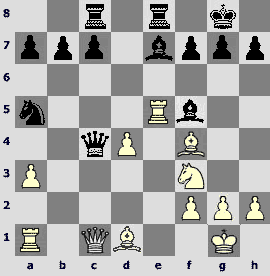
Now Black just loses a piece. He can gather a few pawns for it (20...Јc1 21.Ґc1 Ґf6 22.¦f5 Ґd4 23.¦b1 and so on), but the victory of White is just a question of time. Kramnik decided not to test the technique of Anand and resigned. This crushing defeat is an evidence of a bad sporting form of the Russian champion. 1–0
And now you can see how Ruslan Ponomariov searches for winning chances (and what is surprising, he finds them!) in the endings that seem absolutely drawn at the first glance.
Ponomariov – Polgar (2nd round)
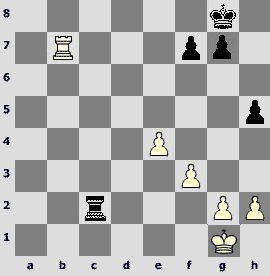
It seems that it is impossible to say something new about this classical endgame.
36.h4. White cannot rescue his king by other means.
36...g6 37.ўh2 ўg7 38.ўg3 ¦e2 39.¦b6 ўf8 40.¦b1 ўg7 41.¦g1. And now he has to make a bit awkward maneuver to move the king forward. But in such an endgame, the main rule is not to hurry. If you have luck, your opponent will come to you by himself!
41...¦a2 42.ўf4 ¦b2 43.g3 ¦b4 44.¦d1 ¦a4 45.ўe3 ¦a2 46.¦d4 ¦g2 47.ўf4 ¦g1. It is a correct defensive plan – attacking the white pawns from the rear, Black prevents the opponent's king to stir to more activity.
48.e5 ¦e1 49.¦e4 ¦g1 50.¦e3 ¦g2 51.¦e1 ¦f2
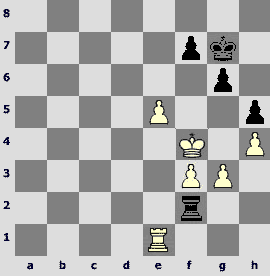
52.g4 (one cannot make progress otherwise) 52...hxg4 53.ўxg4 ¦g2+ 54.ўh3 ¦f2 55.ўg3 ¦a2 56.¦d1 ¦e2 57.¦d5 ¦e1 58.ўf2 ¦h1 59.¦d4 ¦h2+ 60.ўg3 ¦e2 61.¦e4 ¦a2. Black could go into a pawn endgame – 61...¦xe4 62.fxe4 ўf8! 63.ўf4 ўe7 64.ўe3 ўe6 65.ўd4 ўd7! 66.ўd5 ўe7 67.e6 f6! 68.e5 f5=. However, here Black had to make at least some accurate moves, while in a rook ending one can achieve a draw with one hand tied behind one's back, right? Well, such an impression sometimes may be deceptive.
62.¦e3 ¦a1 63.¦d3 ¦e1 64.f4 ¦g1+ 65.ўf3 ¦h1 66.ўg4
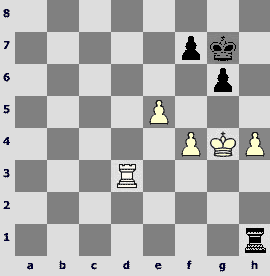
66...f5+?! Here is it – Polgar slightly complicates her life. She could simply stand still: 66...¦g1+ 67.¦g3 ¦h1 68.ўg5 ¦h2.
67.ўg3 ¦g1+ 68.ўf3 ¦h1 69.¦d7+ ўg8 70.ўe3! White has conceived a concrete plan: a breakthrough of the king along with the e-pawn pushing.
70...¦xh4 71.e6 ўf8 (otherwise 72.¦d8 and 73.e7) 72.ўd4!
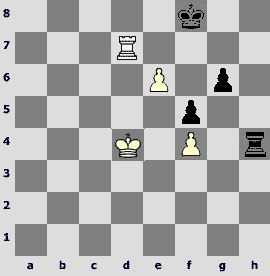
White seems to be close to his aim. A not too experienced player could get scared in such situation and lose.
72...g5! It is the only way to salvation. One has to clear the 6th rank to free the rook.
73.ўe5 gxf4 74.¦f7+. 74...¦h6+ rescues Black in case of 74.ўf6, 74...f3 is a good reply to 74.ўd6.
74...ўe8. Of course, one does not have to play 74...ўg8? 75.¦xf5, and White wins.
75.¦xf5 ¦h1 76.¦xf4 ўe7. Finally, we've ended up in the Philidor position. 77.¦f2 ¦e1+ 78.ўd5 ¦xe6 Ѕ–Ѕ
Ponomariov – Anand (8th round)
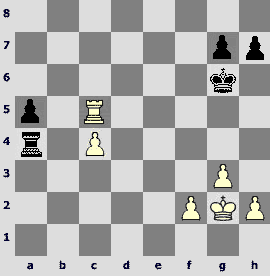
Here everything seems to be easier – soon an endgame "3 vs. 2" should arise. However, even in this case Ponomariov manages to derive maximum benefit from this position, using the presence of pawns on the queenside.
33.ўf3 ¦a2 34.h4 a4 35.¦a5 a3. It seems that there is nothing easier – one just has to exchange the a-pawn for the c-pawn. However, it is actually more complicated – white king has time to defend his pawn.
36.ўe4! ¦e2+ 37.ўd4 a2. 37...¦xf2? 38.¦xa3 is a mistake, and the c-pawn easily queens.
38.f4 ўf6?!. It is an inaccuracy. One had to play 38...h5!, cheapening the white pawns on the kingside.
39.g4!
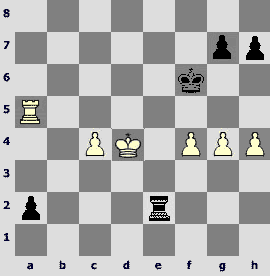
Thanks to the activity of all pieces and pawns, White suddenly receives chances.
39...g6 40.c5. White could have achieved more in case of 40.¦a6+ ўf7 (40...ўg7 41.c5) 41.h5!? ¦f2 42.ўe3 ¦c2 43.ўd3 ¦f2 44.h6! (indicated by S.Shipov), for example: 44...¦xf4 45.¦xa2 ¦xg4 46.¦a7+ ўe6 47.¦xh7, and he should win.
40...¦d2+ 41.ўe4 ¦e2+ 42.ўd3 ¦h2! Now White loses the h-pawn.
43.¦a6+ ўe7 44.ўe4 ¦xh4 45.¦xa2 ¦xg4 46.ўe5
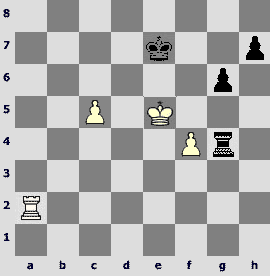
46...ўd7! It is the last accurate move. The c-passer is neutralized.
47.¦a7+ ўc6 48.¦xh7 ўxc5 49.¦c7+ ўb4 50.¦c1 ўb5. Now the draw is inevitable. 51.ўe4 g5 52.¦f1 ¦xf4+ 53.¦xf4 gxf4 54.ўxf4 Ѕ–Ѕ
In this article the annotations of grandmaster Sergei Shipov from the site www.chesspro.ru were used.
